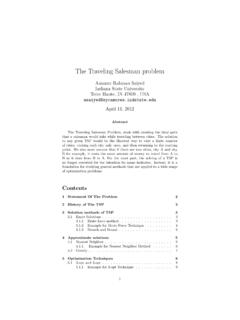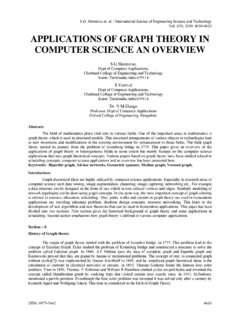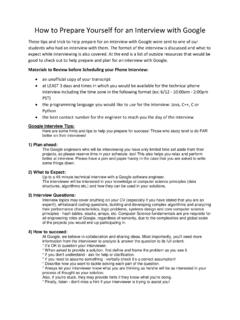Transcription of Networks 1: Shortest path problem - MIT OpenCourseWare
1 1 April 11, 2013 Introduction to Networks 2 Quotes for today "A journey of a thousand miles begins with a single step." -- Confucius You cannot travel the path until you have become the path itself -- Buddha 3 Network Models Optimization models Can be solved much faster than other LPs Applications to industrial logistics, supply chain management, and a variety of systems Today s lecture: introductory material, Eulerian tours, the Shortest Path problem Application of Network Models: 4 Notation and Terminology Note: Network terminology is not (and never will be) standardized. The same concept may be denoted in many different ways. Called: NETWORK directed graph digraph graph 2 1 4 3 2 1 4 3 Class Handouts (Ahuja, Magnanti, Orlin) Node set N = {1, 2, 3, 4} Arc Set Network G = (N, A) {(1,2), (1,3), (3,2), (3,4), (2,4)} Graph G = (V, E) Edge set E Also Seen Vertex set V 5 Directed and Undirected Networks 2 3 4 1 a b c d e An Undirected Graph 2 3 4 1 a b c d e A Directed Graph The field of Network Optimization concerns optimization problems on Networks Networks are used to transport commodities physical goods (products, liquids) communication electricity, etc.
2 6 Networks are Everywhere Physical Networks Road Networks Railway Networks Airline traffic Networks Electrical Networks , , the power grid Communication Networks Social Networks Organizational charts friendship Networks interaction Networks ( , cell calls) 7 Overview: Most models have Networks or graphs as a major aspect Next two lectures: focus on network optimization problems. Next: representations of Networks Pictorial Computer representations LOST: An Illustrative Example Image removed due to copyright restrictions. See interactive graphic The Web of Intrigue in As Lost Ends, Creators Explain How They Did It, What s Going On. Wired Magazine, April 19, 2010. Wired has a handy character chart (yes, there might be spoilers!), created by bioinformics scientist Martin Krzywinski using Circos software (even that sentence is confusing) that shows how all of the characters are related.
3 For example, if you're wondering how many of the characters are related via "romance," click on Romance and the chart will change to show you that. Same with Chance, Family, Occupational, Touched By Jacob, Undisclosed. An elegant representation of arcs UC Berkeley Visualization Lab. All rights reserved. This content is excluded from our CreativeCommons license. For more information, see of advisors James Orlin (1981) Arthur F. Veinott, Jr. (1960) Cyrus Derman (1954) Herbert E. Robbins (1938) Hassler Whitney (1932) George Birkoff (1907) Moore (1885) Newton (1850) Michel Chasles (1814) Simeon Denis Poisson (1800) Joseph Louis Lagrange (1754) Leonhard Euler (1726) Johann Bernoulli (1694) Jacob Bernoulli (1676) Nicolas Malebranche (1672) Gottfried Leibniz (1666) 11 The Adjacency Matrix (for directed graphs) 2 3 4 1 a b c d e A Directed Graph Have a row for each node 1 2 3 4 1 2 3 4 Have a column for each node Put a 1 in row i- column j if (i, j) is an arc What would happen if (4, 2) became (2, 4)?
4 12 The Adjacency Matrix (for undirected graphs) Have a row for each node Have a column for each node Put a 1 in row i- column j if (i, j) is an arc 2 3 4 1 a b c d e An Undirected Graph The degree of a node is the number of incident arcs degree 2 3 2 3 1 2 3 4 1 2 3 4 Note: each arc shows up twice in the adjacency matrix. Question. Is it possible that the number of nodes of odd degree is odd? 13 1. Yes 2. No 14 Arc list representations 2 3 4 1 a b c d e A Directed Graph 1: (1,2), (1,4) 2: (2,3) 3: 4: (4,2), (4,3) (1,2) (1,4) (2,3) (4,2) (4,3) 1 2 3 4 Nodes Arcs Forward Star Representation. Node i points to first arc on arc list whose head is node i. Which uses computer space more efficiently for large road Networks : the adjacency matrix or adjacency lists? 15 1. Adjacency matrix 2. Adjacency lists consider a road network with 10,000 nodes, and with 40,000 arcs The adjacency matrix has 100 million entries.
5 The adjacency list has at most 80,000 entries, two for each road. 16 On network representations Each representation has its advantages Major purpose of a representation efficiency in algorithms ease of use Next: definitions for Networks 17 Directed Path . Example: 1, 2, 5, 3, 4 (or 1, a, 2, c, 5, d, 3, e, 4) No node is repeated. Directions are important. Cycle (or circuit or loop) 1, 2, 3, 1. (or 1, a, 2, b, 3, e) A path with 2 or more nodes, except that the first node is the last node. Directions are ignored. Path: Example: 5, 2, 3, 4. (or 5, c, 2, b, 3, e, 4) No node is repeated. Directions are ignored. Directed Cycle: (1, 2, 3, 4, 1) or 1, a, 2, b, 3, c, 4, d, 1 No node is repeated, except that the first node is the last node. Directions are important. 2 3 4 a b c 1 5 d e 2 3 4 a b c d 1 e 2 3 4 a b c 1 5 d e 2 3 4 a b c d 1 e 18 Walks 2 3 4 1 a b c d e 5 2 3 4 1 a b c d e 5 Walks are paths that can repeat nodes and arcs Example of a directed walk: 1-2-3-5-4-2-3-5 A walk is closed if its first and last nodes are the same.
6 A closed walk is a cycle except that it can repeat nodes and arcs. 19 More terminology An undirected network is connected if every node can be reached from every other node by a path 2 1 4 3 5 2 1 4 3 5 A directed network is connected if it s undirected version is connected. This directed graph is connected, even though there is no directed path between 2 and 5. 20 On connectivity 6 1 4 3 7 2 10 8 9 5 There are simple efficient procedures for determining if a graph is connected. Here is a graph with two components, that is maximally connected subgraphs. 4 7 10 9 We will not describe these algorithms, but will do a more general algorithm later in this lecture 21 The Bridges of Koenigsberg: Euler 1736 Graph Theory began in 1736 Leonard Euler Visited Koenigsberg People wondered whether it is possible to take a walk, end up where you started from, and cross each bridge in Koenigsberg exactly once Generally it was believed to be impossible 22 The town of Koenigsberg A B D C Annotated map source unknown.
7 All rights reserved. This content is excluded from ourCreative Commons license. For more information, see The Bridges of Koenigsberg: Euler 1736 A D C B 1 2 4 3 7 6 5 Is it possible to start in A, cross over each bridge exactly once, and end up back in A? 24 The Bridges of Koenigsberg: Euler 1736 A D C B 1 2 4 3 7 6 5 Conceptualization: Land masses are nodes 25 The Bridges of Koenigsberg: Euler 1736 1 2 4 3 7 6 5 Conceptualization: Bridges are arcs A C D B 26 The Bridges of Koenigsberg: Euler 1736 1 2 4 3 7 6 5 Translation to graphs or Networks : Is there a walk starting at A and ending at A and passing through each arc exactly once? Why isn t there such a walk? A C D B 27 Adding two bridges creates such a walk A, 1, B, 5, D, 6, B, 4, C, 8, A, 3, C, 7, D, 9, B, 2, A 1 2 4 3 7 6 5 A C D B 8 9 Here is the walk. Note: the number of arcs incident to B is twice the number of times that B appears on the walk.
8 28 Eulerian cycle: a closed walk that passes through each arc exactly once Degree of a node = number of arcs incident to the node Necessary condition: each node has an even degree. Why necessary? The degree of a node j is twice the number of times j appears on the walk (except for the initial and final node of the walk.) Theorem. A graph has an eulerian cycle if and only if the graph is connected and every node has even degree. 29 Eulerian path: a walk that is not closed and passes through each arc exactly once Theorem. A graph has an Eulerian path if and only if exactly two nodes have odd degree and the graph is connected. 30 Eulerian cycles Eulerian cycles and extensions are used in practice Mail Carrier routes: visit each city block at least once minimize travel time other constraints in practice? Trash pickup routes visit each city block at least once minimize travel time other constraints in practice?
9 traveling salesman problem The 48 city problem . 31 George Dantzig, Ray Fulkerson, and Selmer Johnson (1954) Mental Break 32 33 More Definitions A network is connected if every node can be reached from every other node by a path 2 1 4 3 5 A spanning tree is a connected subset of a network including all nodes, but containing no cycles. 2 1 4 3 5 2 1 4 3 5 2 1 4 3 5 34 More on Trees An out-tree is a spanning tree in which every node has exactly one incoming arc except for the root. Theorem. In an out-tree, there is a directed path from the root to all other nodes. (All paths come out of the root). One can find the path by starting at the end and working backwards. 2 1 4 3 5 2 1 4 3 5 7 8 9 6 10 11 12 13 13 35 The Shortest Path problem 1 2 3 4 5 6 2 4 2 1 3 4 2 3 2 What is the Shortest path from a source node (often denoted as s) to a sink node, (often denoted as t)? What is the Shortest path from node 1 to node 6?
10 Assumptions for this lecture: 1. There is a path from the source to all other nodes. 2. All arc lengths are non-negative 36 Shortest Path problem Where does it arise in practice? Common applications Shortest paths in a vehicle (Navigator) Shortest paths in internet routing Shortest paths around MIT and less obvious applications, as in the course readings (see URL on slide 3 of this lecture). How will we solve the Shortest path problem ? Dijkstra s algorithm Application 1: Shortest paths in a Transportation Network 37 Add a node for every intersection . Add arcs for roads. 38 Dijkstra s Algorithm Exercise: find the Shortest path from node 1 to all other nodes. Keep track of distances using labels, d(i) and each node s immediate predecessor, pred(i). d(1)= 0, pred(1)=0; d(2) = 2, pred(2)=1 Find the other distances, in order of increasing distance from node 1. 1 2 3 4 5 6 2 4 2 1 3 4 2 3 2 Exercise: Find the Shortest paths by inspection.















